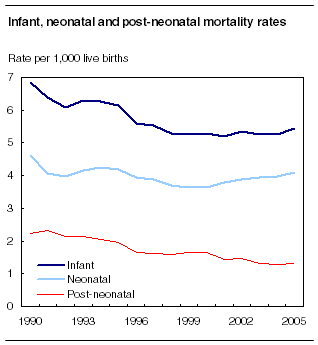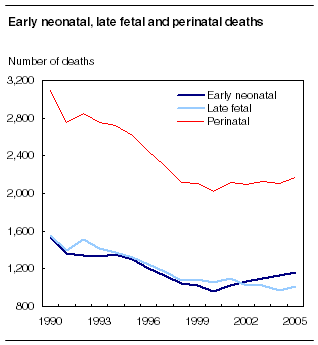Common menu bar links
Deaths
Archived Content
Information identified as archived is provided for reference, research or recordkeeping purposes. It is not subject to the Government of Canada Web Standards and has not been altered or updated since it was archived. Please "contact us" to request a format other than those available.

The number of deaths registered in Canada recorded its fastest increase in three years in 2005, continuing a long-term upward trend in the wake of a growing and aging population.
In addition, new data on mortality show that the gap in the annual number of deaths continued to narrow between men and women, and that the average age at death rose steadily from 1990 to 2005.
A total of 230,132 people died in Canada in 2005, up 1.6% from 2004, the fastest annual increase since a 1.9% increase in 2002. It follows a rise of only 0.2% in 2004, which was one of the smallest annual increases in the number of deaths in 25 years.
Between 2004 and 2005, age-specific mortality rates actually declined in older age groups, that is, among people aged 50 and older, offsetting increases in rates at younger age groups.
Of these individuals, 116,006 were men, a 1.3% increase from 2004, and 114,126 women, a 1.8% increase. For every 100 female deaths in 2005, there were 102 male deaths. This was well below the ratio of 135 male deaths per 100 females in 1979.
Between 1990 and 2005, the annual number of deaths increased by 20%. However, the percentage increase among women during this period, about 30%, was more than twice the rate of growth among men, about 12%.
| Mean age at death, by geography, 2005 | ||||
|---|---|---|---|---|
| Both sexes | Male | Female | Male-female gap | |
| years | ||||
| Canada | 74.2 | 71.1 | 77.4 | 6.3 |
| Newfoundland and Labrador | 73.7 | 71.3 | 76.4 | 5.2 |
| Prince Edward Island | 75.6 | 72.1 | 78.9 | 6.8 |
| Nova Scotia | 75.3 | 72.3 | 78.4 | 6.1 |
| New Brunswick | 75.1 | 72.0 | 78.2 | 6.2 |
| Quebec | 74.0 | 70.6 | 77.4 | 6.7 |
| Ontario | 74.5 | 71.5 | 77.5 | 6.0 |
| Manitoba | 74.6 | 71.6 | 77.6 | 6.0 |
| Saskatchewan | 75.3 | 72.6 | 78.2 | 5.6 |
| Alberta | 71.6 | 68.4 | 75.2 | 6.8 |
| British Columbia | 74.6 | 71.6 | 77.8 | 6.3 |
| Yukon | 66.2 | 63.5 | 71.0 | 7.5 |
| Northwest Territories | 61.1 | 59.4 | 64.6 | 5.2 |
| Nunavut | 47.8 | 49.5 | 44.6 | -4.9 |
Age 50 or older mortality rates on decline
Between 2004 and 2005, mortality rates among people aged 50 or older declined, offsetting increases in rates among people at younger ages.
Increase in average age at death
From 1990 to 2005, the average age at death for both sexes rose steadily. Among men, it increased by 3.5 years, and among women, by 3.2 years.
In 2005, the average age at death for the population as a whole was 74.2 years. For men it was 71.1 years, which was 6.3 years less than the 77.4 years for women. The average age at death for men was lower than it was for women in all provinces and territories, except for Nunavut.
In Nunavut, the average age at death of 47.8 years was the lowest in Canada in 2005. It was highest at 75.6 years in Prince Edward Island.
| Deaths by geography | |||
|---|---|---|---|
| 2004 | 2005 | 2004 to 2005 | |
| number | % change | ||
| Canada | 226,584 | 230,132 | 1.6 |
| Male | 114,513 | 116,006 | 1.3 |
| Female | 112,071 | 114,126 | 1.8 |
| Newfoundland and Labrador | 4,308 | 4,486 | 4.1 |
| Prince Edward Island | 1,223 | 1,118 | -8.6 |
| Nova Scotia | 8,241 | 8,273 | 0.4 |
| New Brunswick | 6,247 | 6,175 | -1.2 |
| Quebec | 55,624 | 55,787 | 0.3 |
| Ontario | 83,142 | 85,591 | 2.9 |
| Manitoba | 9,903 | 9,856 | -0.5 |
| Saskatchewan | 8,844 | 8,850 | 0.1 |
| Alberta | 18,675 | 19,288 | 3.3 |
| British Columbia | 29,923 | 30,227 | 1.0 |
| Yukon | 166 | 164 | -1.2 |
| Northwest Territories | 153 | 148 | -3.3 |
| Nunavut | 121 | 115 | -5.0 |
Infant mortality rate relatively stable in recent years
From 1998 to 2005, infant mortality (deaths of infants aged less than one year old) was relatively stable at around 5.3 infant deaths per 1,000 live births.
Prior to the late 1990s, infant mortality rates had been declining steadily, falling from 10.5 in 1980 to 6.8 in 1990, before stabilizing around 5.3 from 1998 until 2005.
The infant mortality rate rose slightly from 5.3 deaths per 1,000 live births in 2004 to 5.4 in 2005. The male infant mortality rate increased from 5.5 to 5.9 infant deaths per 1,000 live births, while the female rate remained at 5.0.
From 2004 to 2005, the overall increase in the male infant mortality rate in Canada was mainly due to increases in Newfoundland and Labrador, Quebec, Saskatchewan, Alberta, British Columbia and the Northwest Territories. Increases in these jurisdictions offset declines in the other five provinces and two territories.
Internationally, the Organisation for Economic Co-operation and Development countries' average infant mortality rates fell from 11.0 in 1990 to 5.4 in 2005, while Canada's rate went from 6.8 to 5.4 during the same period.
Between 1990 and 2005, the two countries with the lowest infant mortality, Japan and Sweden, saw rates fall from 4.6 to 2.8 and 6.0 to 2.4 respectively.
Diverging trends in neonatal and post-neonatal mortality rates
Infant mortality can be subdivided into neonatal mortality (deaths of infants aged 0 to 27 days) and post-neonatal mortality (deaths of infants aged 28 to 364 days).
From 1990 to 2005, trends in the neonatal and post-neonatal mortality rates followed different directions.
The neonatal mortality rate declined 11% from 4.6 deaths per 1,000 live births in 1990, to 4.1 in 2005, while the post-neonatal mortality rate fell 41% from 2.2 deaths per 1,000 live births to 1.3.
However, between 1998 and 2005, the neonatal mortality rate was on the rise, while the post-neonatal mortality rate was decreasing.
Canada's neonatal mortality rate rose slightly from 4.0 deaths per 1,000 live births in 2004 to 4.1 in 2005. The post-neonatal rate remained at 1.3 deaths per 1,000 live births in both years.

Little variation in perinatal deaths
Trends in the two components of perinatal deaths, early neonatal (deaths of infants aged 0 to 6 days) and late fetal deaths (stillbirths with 28 or more weeks' gestation), differed over the previous 15 years.
The number of late fetal deaths generally declined during this period. The number of early neonatal deaths declined from 1990 to 2000, but increased from 2000 to 2005. During the same period, the increase in early neonatal deaths was mainly due to deaths of infants under 1 day old.
As a result of these two divergent trends, perinatal deaths stalled at around 2,100 deaths from 1998 to 2005.

Available on CANSIM: tables 102-0501 to 102-0511.
Definitions, data sources and methods: survey number 3233.
The 2005 issue of the publication Deaths (84F0211XWE, free) is now available from the Publications module of our website.
For general information or to order custom tabulations, contact Client Services (613-951-1746; hd-ds@statcan.gc.ca). To enquire about the concepts, methods or data quality of this release, contact Shiang Ying Dai (613-951-1759) or Brigitte Chavez (613-951-1593), Health Statistics Division.

